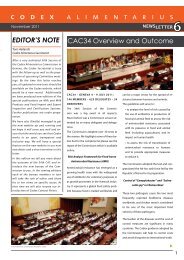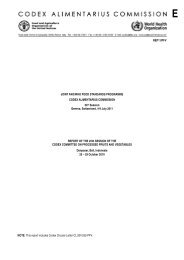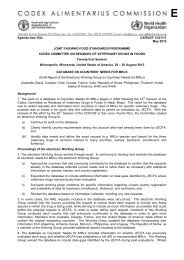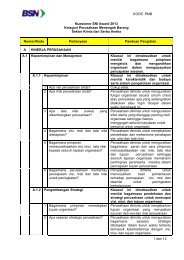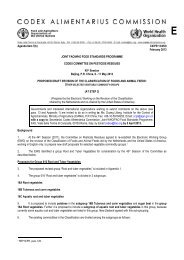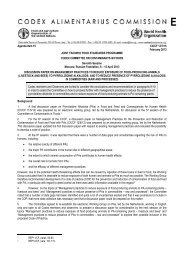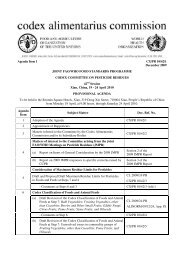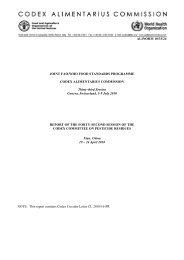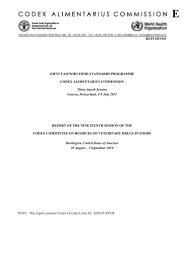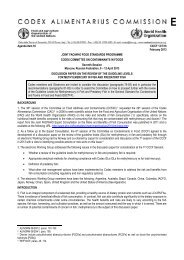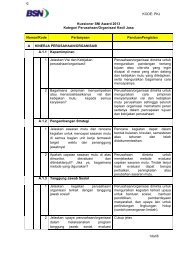alinorm 10/33/41 - CODEX Alimentarius
alinorm 10/33/41 - CODEX Alimentarius
alinorm 10/33/41 - CODEX Alimentarius
Create successful ePaper yourself
Turn your PDF publications into a flip-book with our unique Google optimized e-Paper software.
ALINORM <strong>10</strong>/<strong>33</strong>/<strong>41</strong> 536. JECFA considered three different exposure scenarios depending on the level of inorganic arsenic in drinkingwater. If the level of inorganic arsenic in drinking water is below the WHO drinking water guideline level of<strong>10</strong> µg/l, food can contribute a relatively high proportion to oral exposure to inorganic arsenic, but total exposure(from food and drinking water) may be of low health concern. In areas where levels in drinking water are in therange of <strong>10</strong>-50 µg/l there is significant exposure to inorganic arsenic through food and drinking water and possiblehealth effects could occur. However, they would occur at low incidence and would be difficult to detect inepidemiological studies. In areas where drinking water levels of inorganic arsenic of 50-<strong>10</strong>0 µg/l occur, someepidemiological studies provide evidence for adverse effects.Deoxynivalenol (DON) and its metabolites37. JECFA extended the existing PMTDI for DON and established a group PMTDI of 1 µg/kg body weight forDON and its acetylated derivatives. An acute reference dose (ARfD) of 8 µg/kg body weight was established forDON and its acetylated derivatives.Furan38. The information available suggests that the major route of exposure is through consumption of heat-treatedfoods and beverages such as coffee and canned and jarred baby foods. The average and high dietary exposure wasestimated to 0.001 mg/kg bw and 0.002 mg/kg bw, respectively. Furan is a carcinogenic compound and JECFAconcluded that the estimated margins of exposure indicate a potential human health concern. However, there iscurrently a lack of quantitative data for all types of foods and ways on how furan levels may be reduced in heattreatedfoods.Mercury39. JECFA reviewed toxicological data on inorganic mercury and established a new PTWI of 0.004 mg/kg. Theold PTWI for total mercury 0.005 mg/kg was withdrawn. Since normally only total mercury is measured in foods,the available total mercury data were used to estimate exposure. JECFA estimated the upper limits of averagedietary exposure to total mercury from foods other than fish and shell-fish were for adults 0.001 mg/kg bw perweek and for children 0.004 mg/kg bw per week.Perchlorate40. Perchlorate is present in the environment, water, soil and fertilizers, and are considered potential sources forcontamination of food. JECFA established a PMTDI of 0.01 mg/kg bw and the estimated dietary exposure throughfood and drinking water (highest 0.7 µg/kg bw and day) did not indicate a human health concern.<strong>41</strong>. In view of the above-mentioned information, the Committee agreed that the in-session Working Group onPriorities (see Agenda Item 1) should also consider this information and make recommendations on future newwork for the Committee. In making their recommendations, the Committee also agreed that this working groupshould consider the proposals for new work made under Agenda Item 1 and that the recommendations of theworking group would be discussed under Agenda Item 11 – Other business and future work.MATTERS OF INTEREST ARISING FROM OTHER INTERNATIONAL ORGANISATIONS (AgendaItem 3b) 542. The Committee noted the information provided by the International Atomic Energy Agency as provided indocument CX/CF <strong>10</strong>/4/3-Add.1 especially with regard to the activities of the Coordinated Research Project onApplications of Radiotracer and Radio-assay Technologies to Seafood Safety Risk Analysis and the conclusions ofthe research coordination meeting related to Codex activities.PROPOSED DRAFT CODE OF PRACTICE FOR THE REDUCTION OF ETHYL CARBAMATE INSTONE FRUIT DISTILLATES (Agenda Item 4) 643. The Delegation of Germany introduced Conference Room Document 12 highlighting the main revisionsmade to working document CX/CF <strong>10</strong>/4/4 based on the written comments submitted in the addenda to thisdocument. The Delegation indicated that the revision related to both the structure and content of the document inorder to facilitate the understanding and implementation of the Code.56CX/CF <strong>10</strong>/4/3-Add.1.CX/CF <strong>10</strong>/4/4; CX/CF <strong>10</strong>/4/4-Add.1 (comments of Brazil, Canada, Chile, Japan, United States of America, FAO andCIAA); CX/CF <strong>10</strong>/4/6-Add.2 (comments of Thailand); CRD 4 (comments of Kenya); CRD 9 (comments of the EU);CRD 12 (Code of Practice for the Prevention and Reduction of Ethyl Carbamate Contamination in Stone Fruit 1 strevision, Germany); CRD 20 (Code of Practice for the Prevention and Reduction of Ethyl Carbamate Contamination inStone Fruit, 2 nd revision, Germany).



